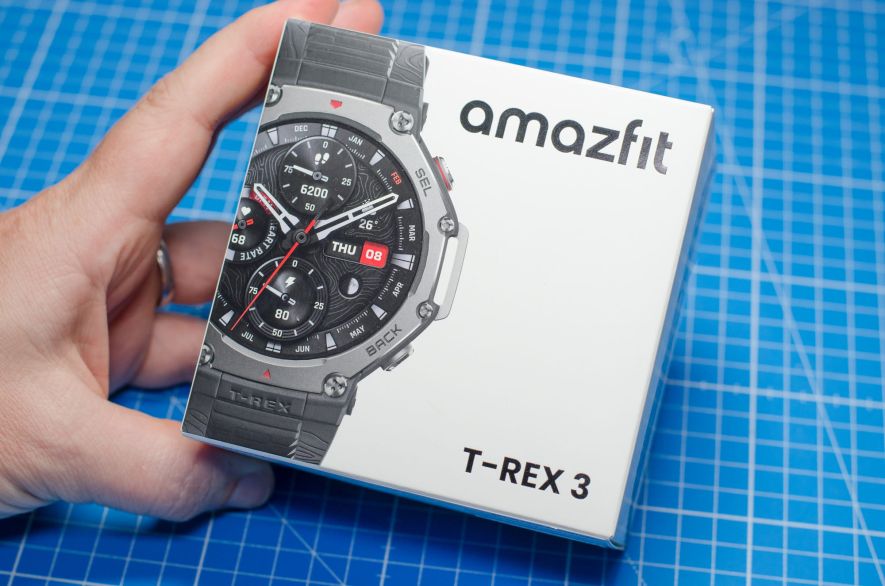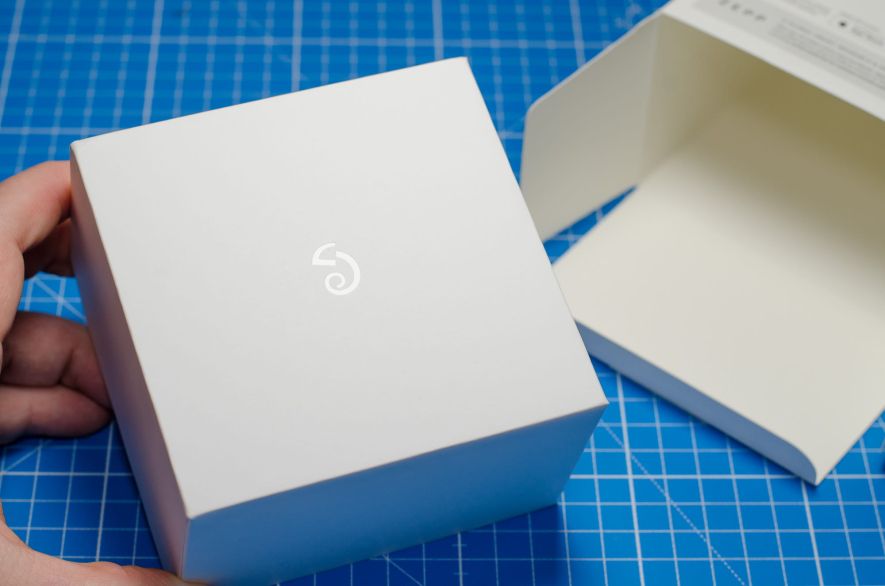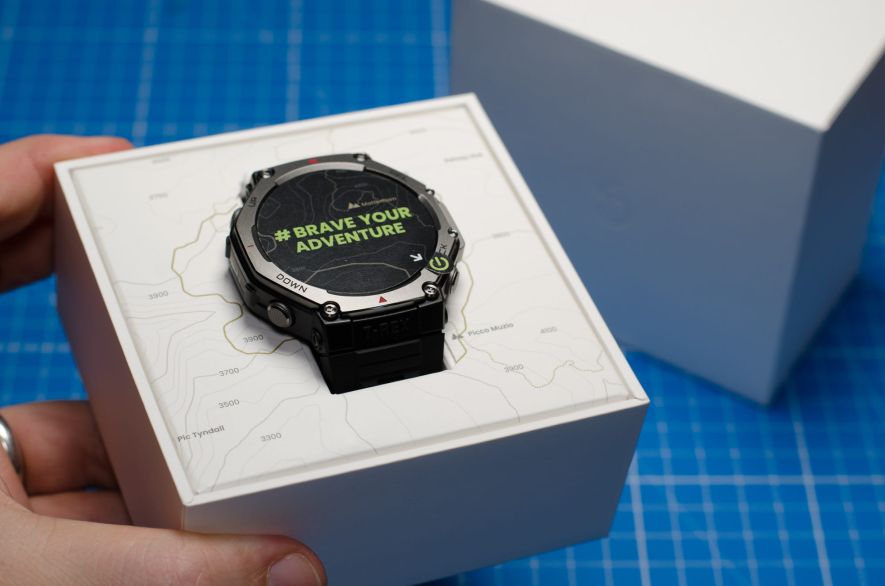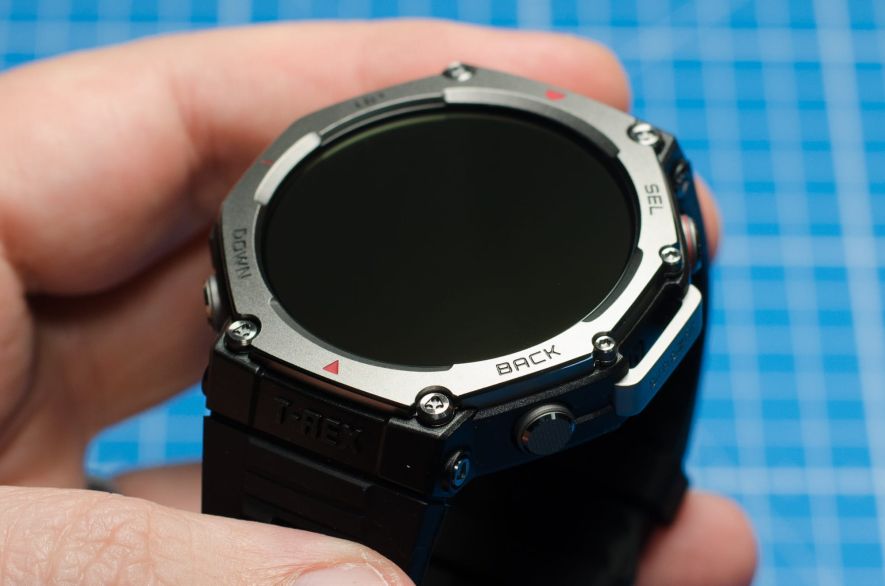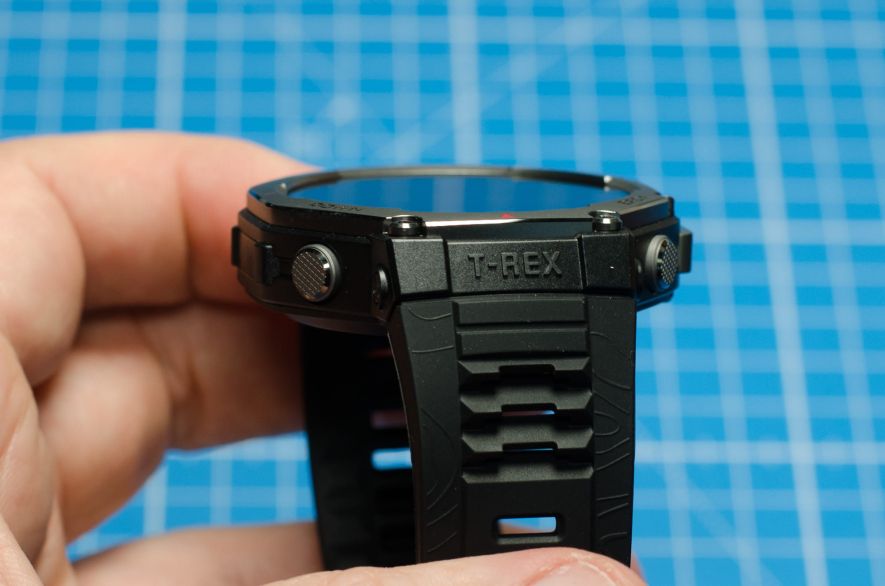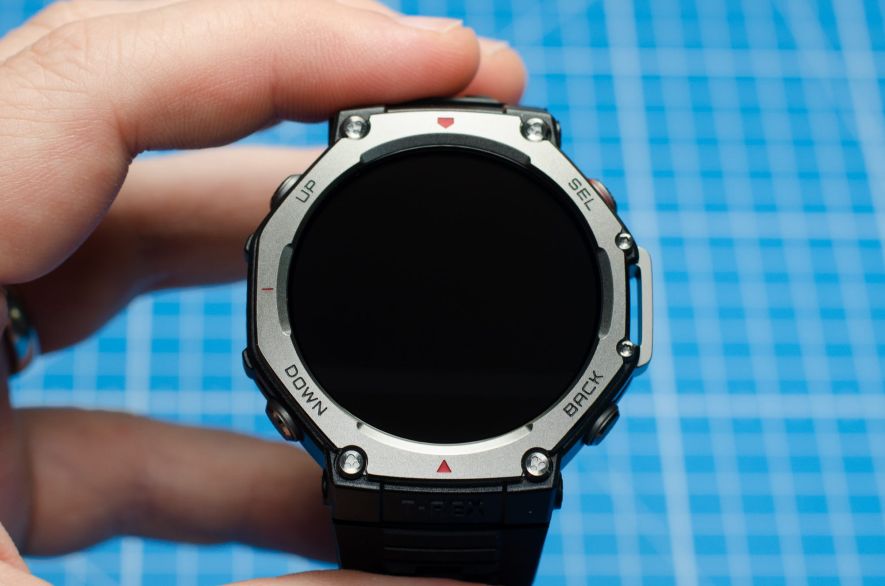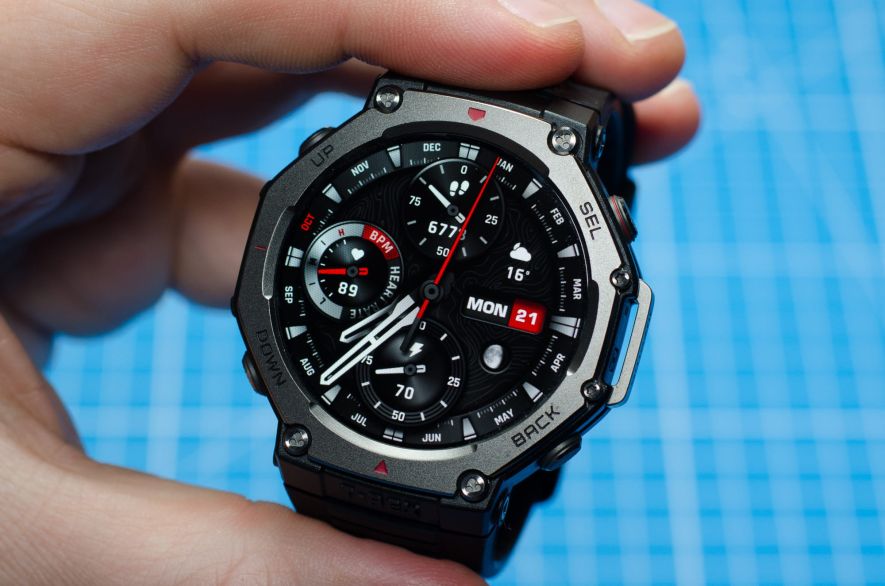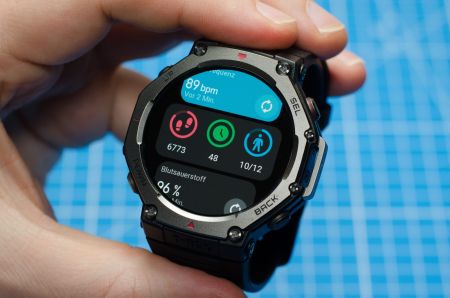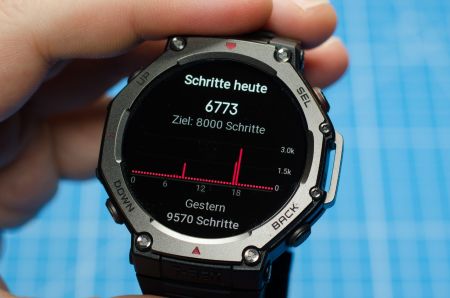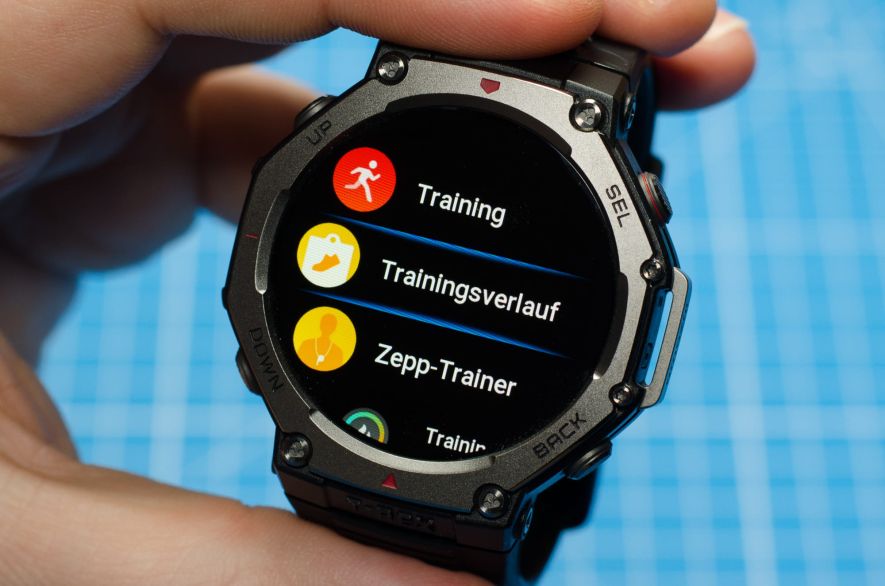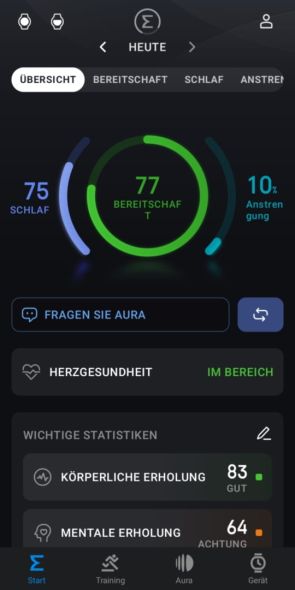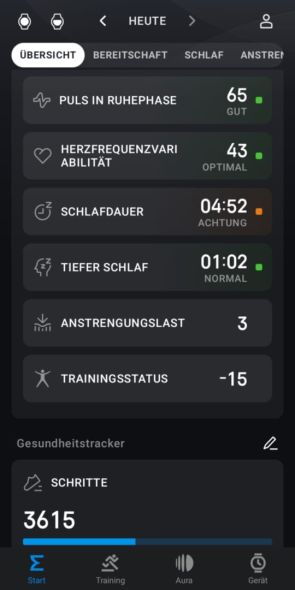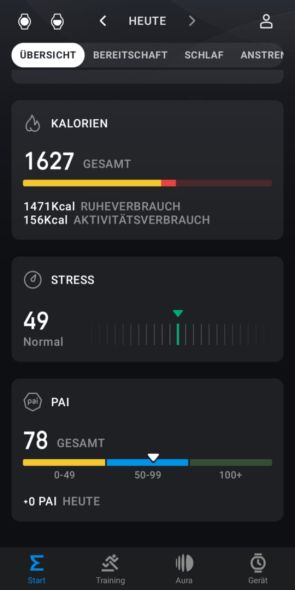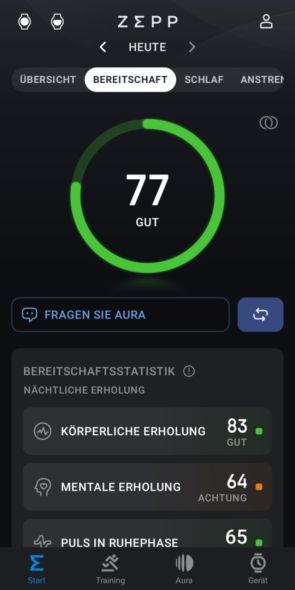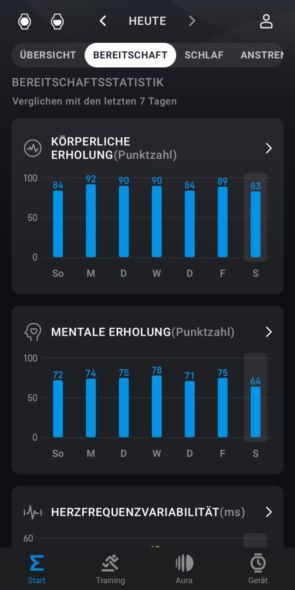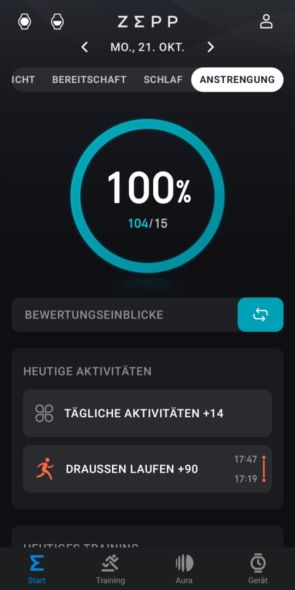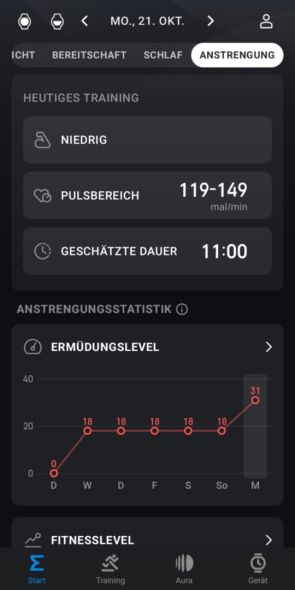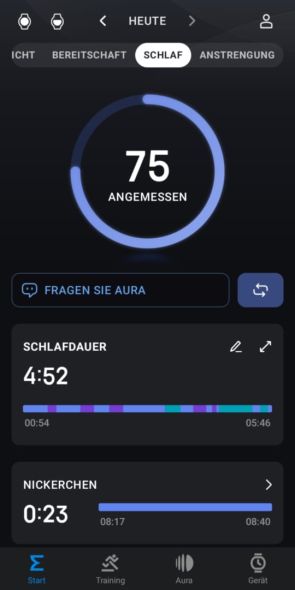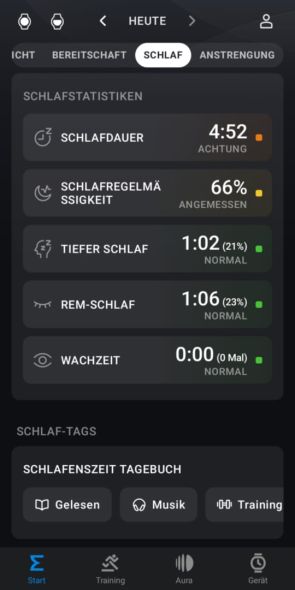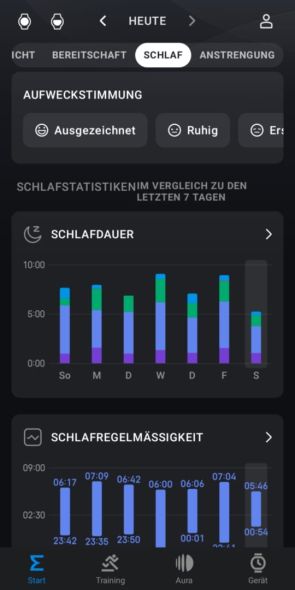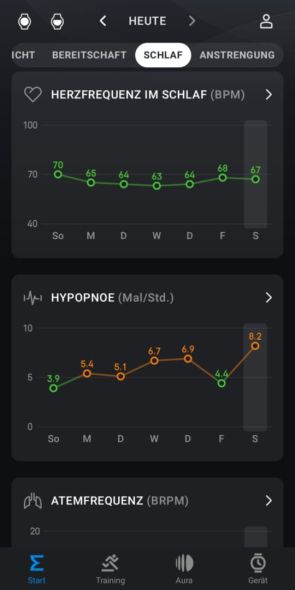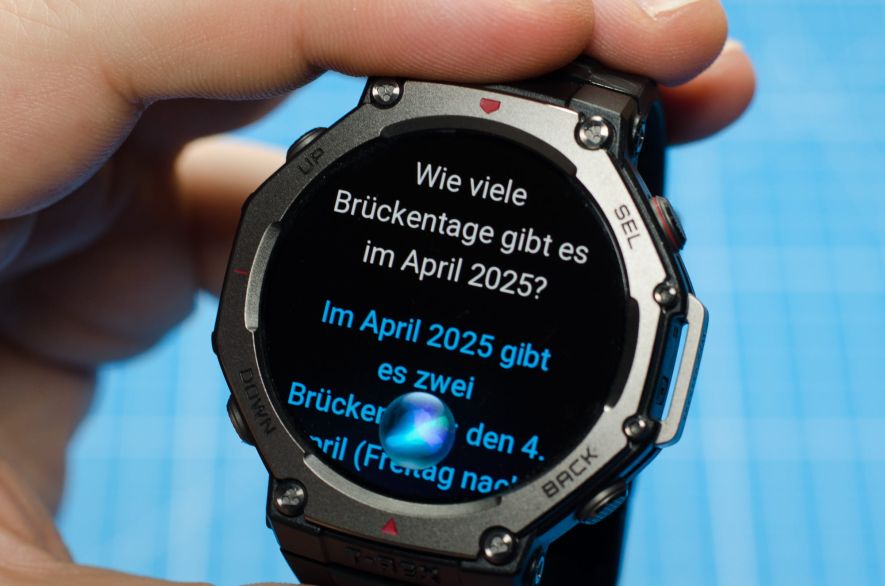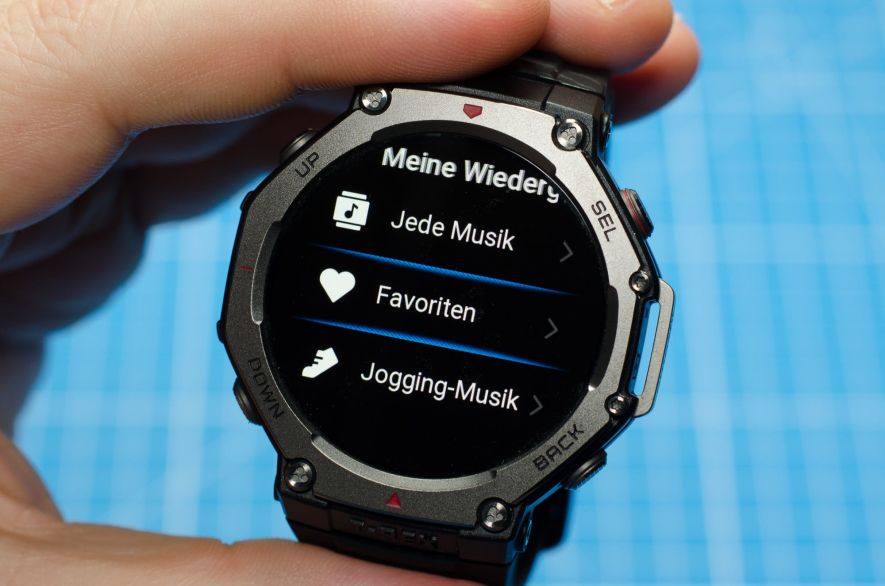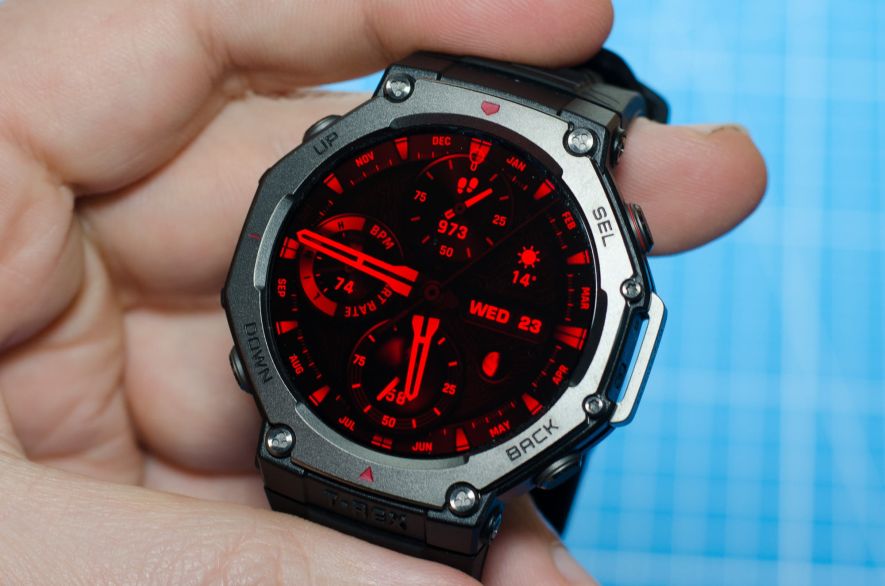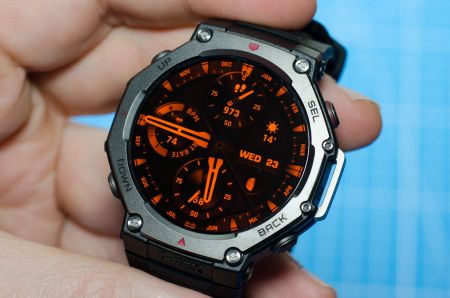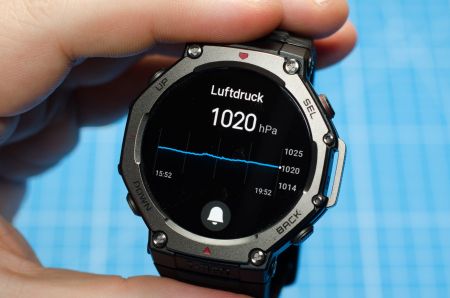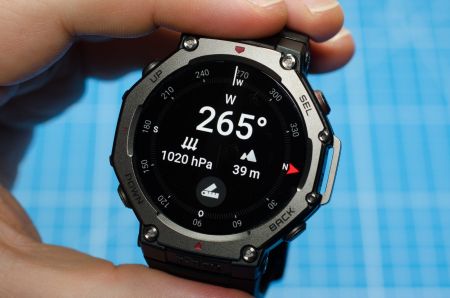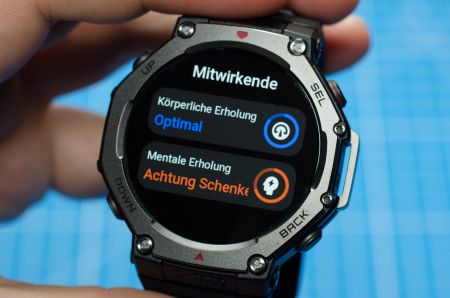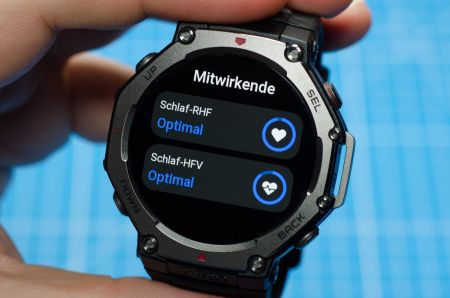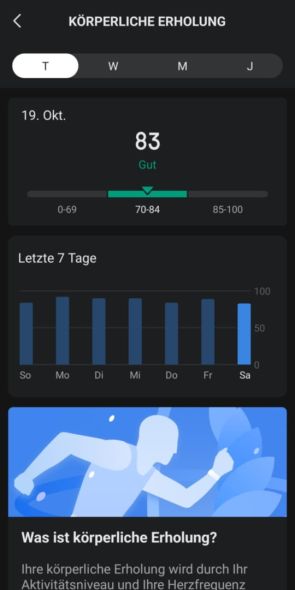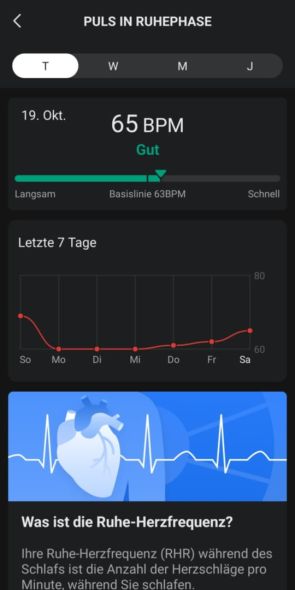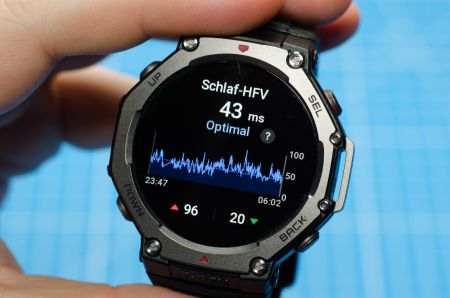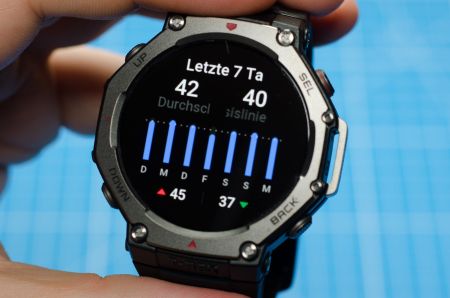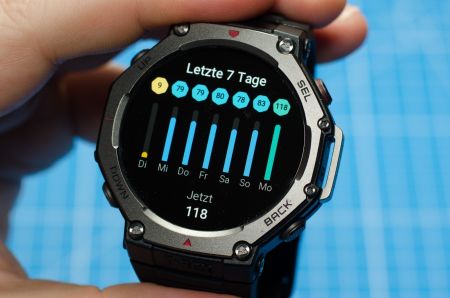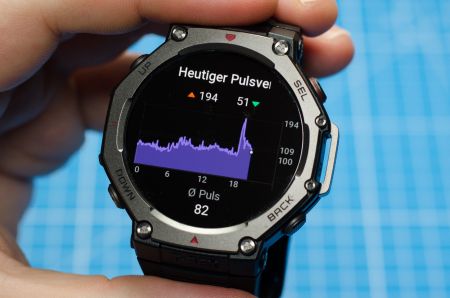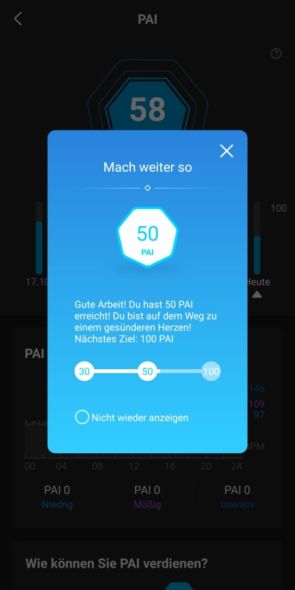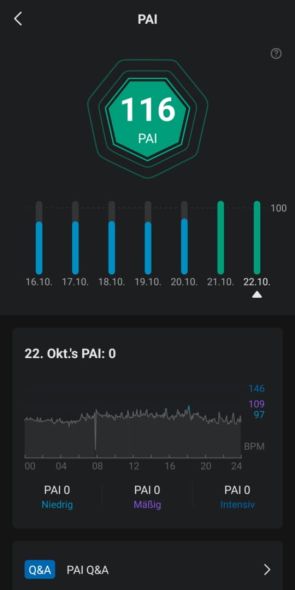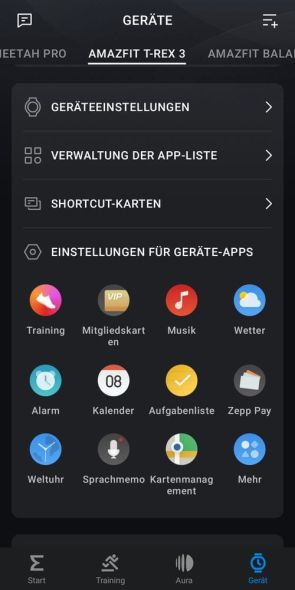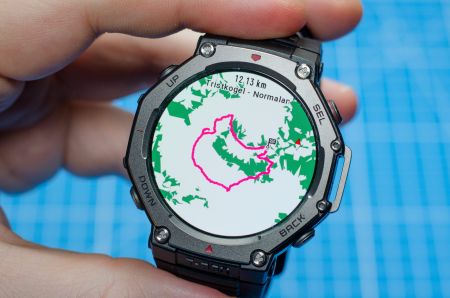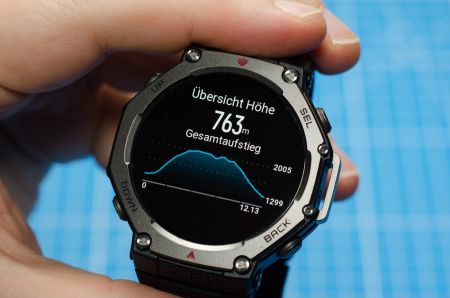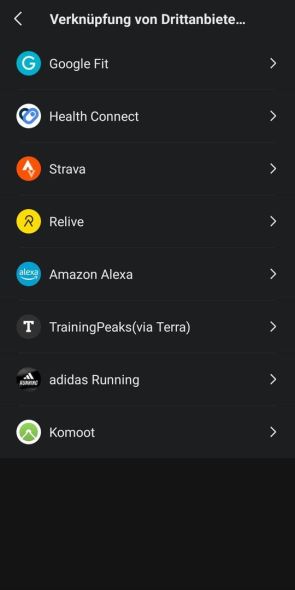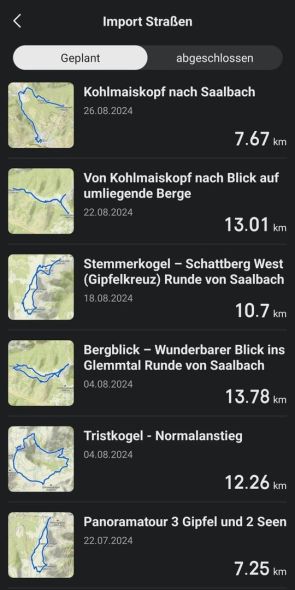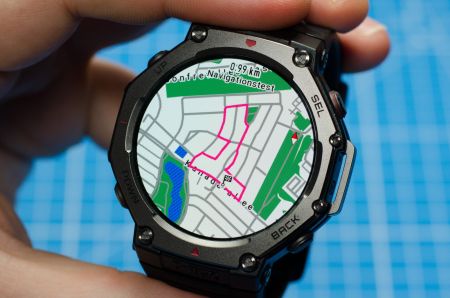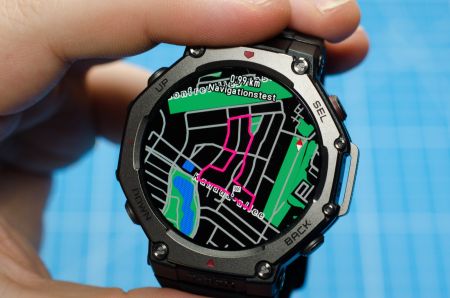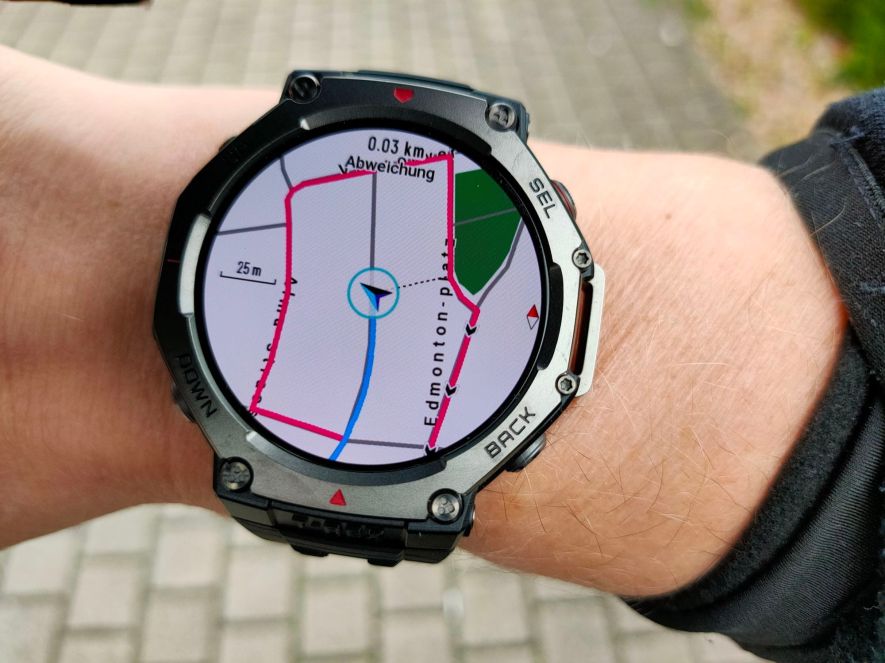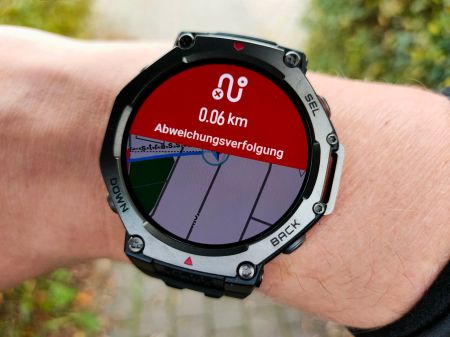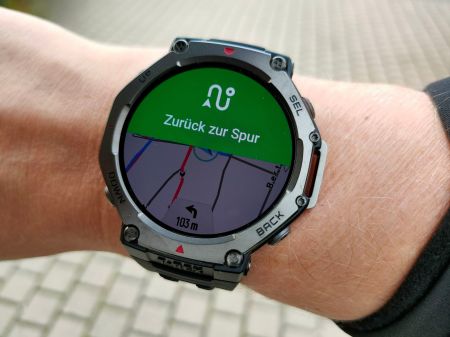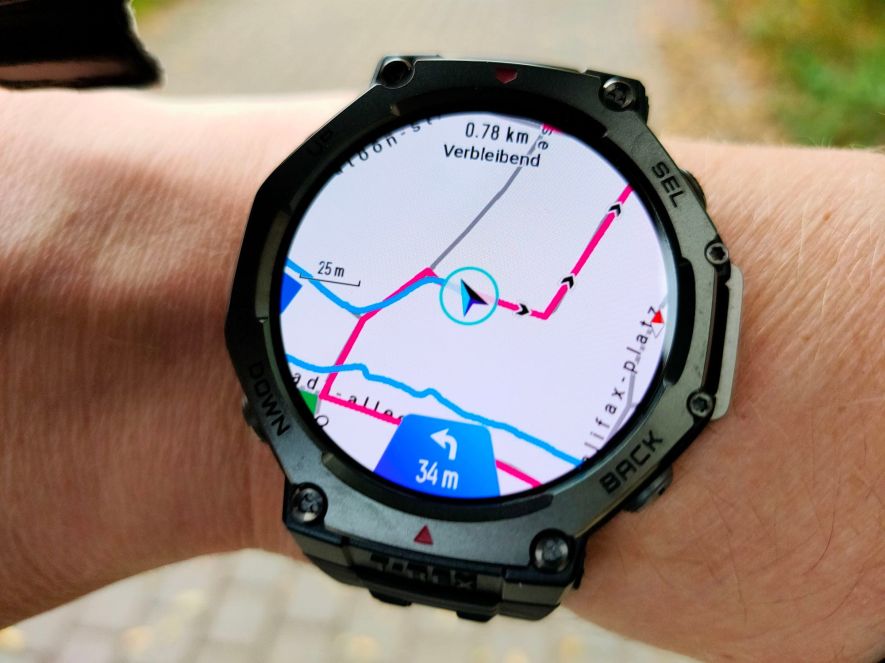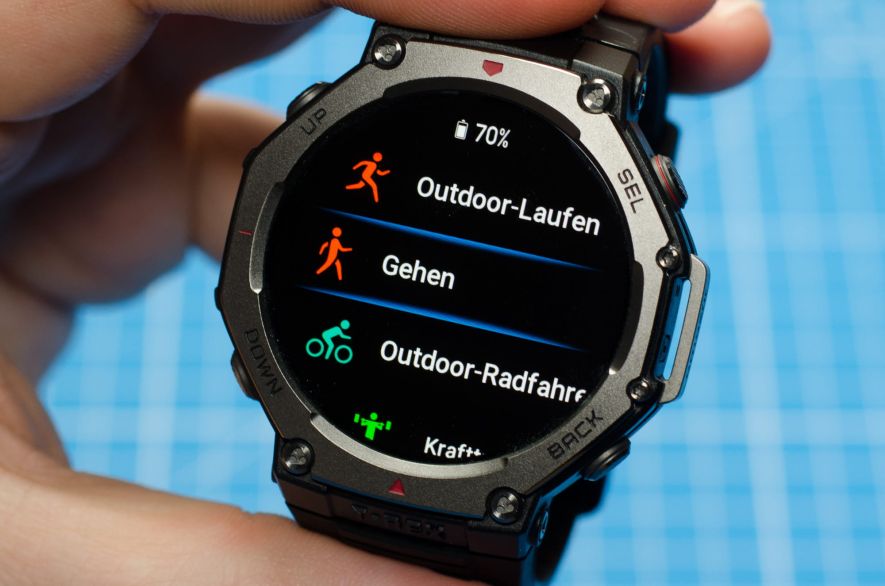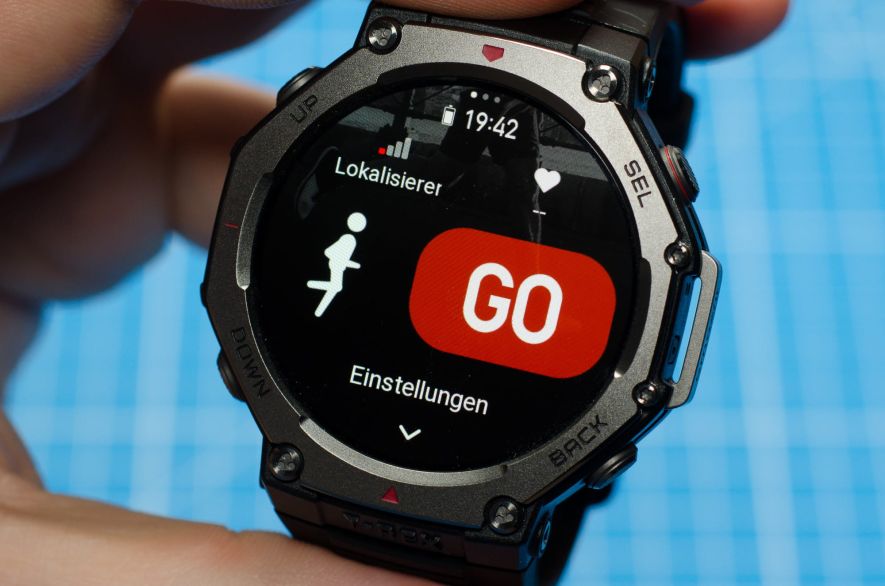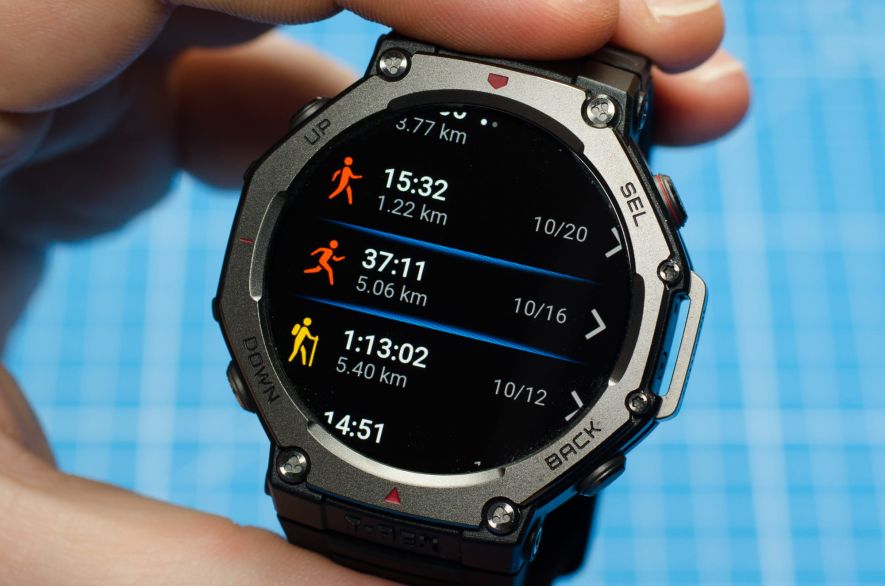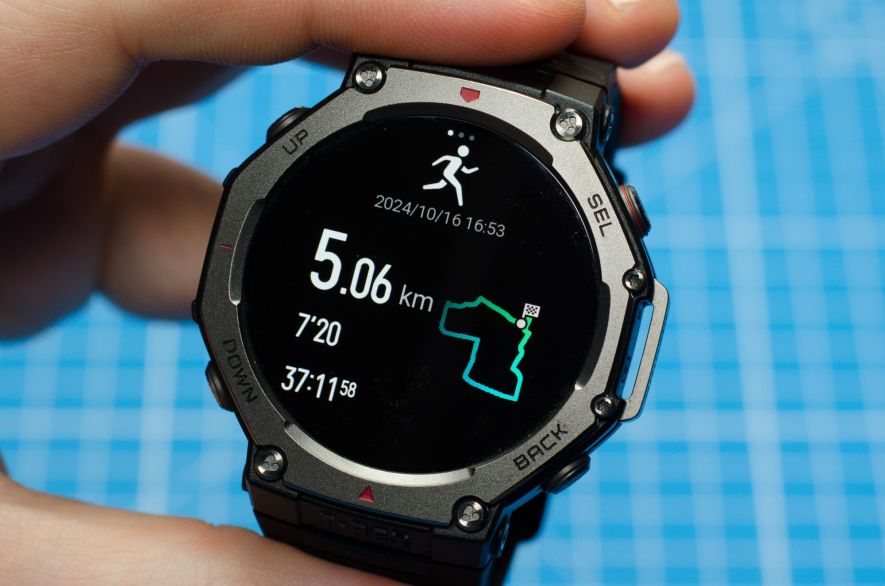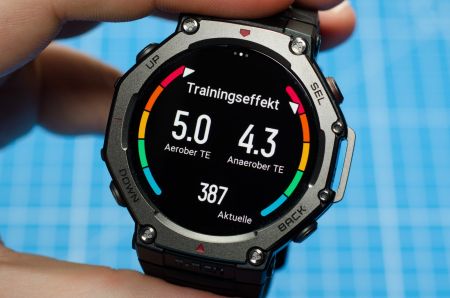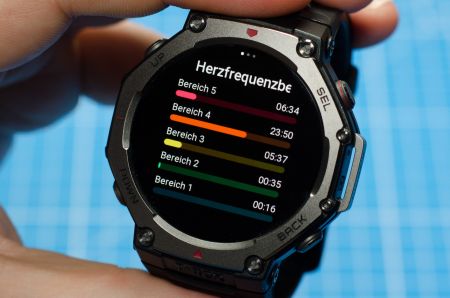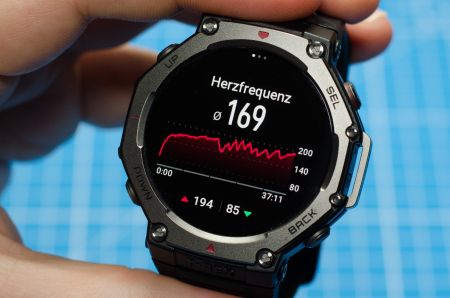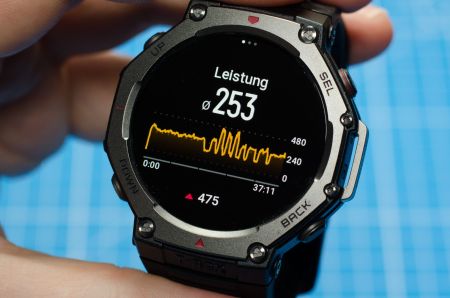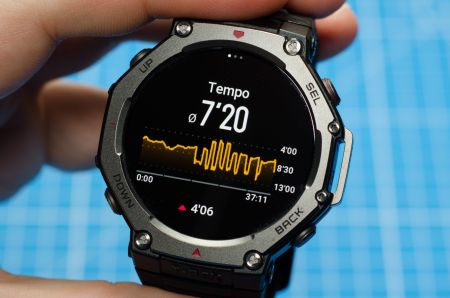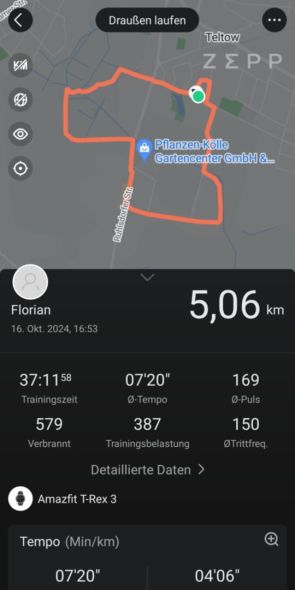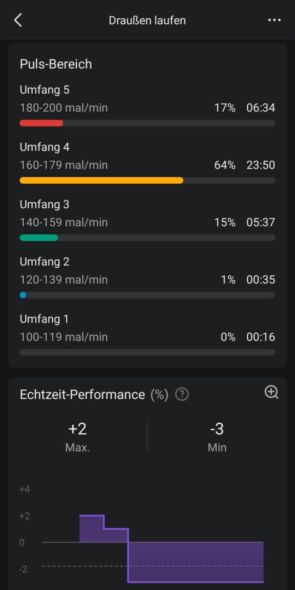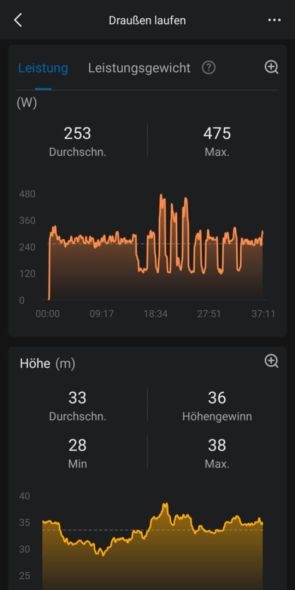Amazfit T-Rex 3 review: A Fenix challenger for a fraction of the price
At IFA 2024, Amazfit unveiled the T-Rex 3, the latest iteration of its rugged outdoor smartwatch. In this review, I will dive into all the watch’s new features, highlighting both its strengths and areas for improvement.
If there is one brand that has made a name for itself in recent years, it is Amazfit. And rightly so, as Zepp (the company behind the Amazfit brand) mostly produces smartwatches that can usually qualified as very strong value-for-money. Models from Amazfit are available for a fraction of what you would pay for similar devices from Garmin and most of the time, the functional differences are minimal.
As both companies offer an extensive range of models, it is quite difficult to decide on a particular one. Hopefully, this review will help to simplify that procedure as well.
Amazfit T-Rex 3 Overview
Let’s start with giving some context: The T-Rex 3 is the latest generation of Amazfit’s T-Rex series. Some time has passed since the release of its predecessor in may 2022, so the following table compares the key specifications of the T-Rex 3 against the T-Rex 2 and its competition:
| T-Rex 3 | Grit X2 Pro | fenix 8 - 51 mm | Race | |
|---|---|---|---|---|
| Display | AMOLED | AMOLED | AMOLED | AMOLED |
| Display size | 1.50" | 1.39" | 1.40" | 1.43" |
| Displayform | rund | rund | rund | rund |
| Resolution | PPI | 480 × 480 | 320 | 454 × 454 | 327 | 454 × 454 | 324 | 466 × 466 | 326 |
| Dimensions | 48.5 × 48.5 × 13.7 mm | 48.6 × 48.6 × 13.4 mm | 51.0 × 51.0 × 14.7 mm | 49.0 × 49.0 × 13.3 mm |
| Weight | 68 g with strap | 57 g without strap | 74 g without strap | 83 g with strap |
| Material (bezel) | Stainless Steel | Stainless Steel | Stainless Steel | Stainless Steel |
| Material (case) | Plastic (no further details provided) | Stainless Steel | Fiber-reinforced polymer | Fiber-reinforced polymer |
In terms of the very basic specs, the products are quite similar. The T-Rex 3 stands out primarily for its 1.5″ AMOLED display. With a resolution of 480 x 480 pixels, the display boasts a pixel density of 320 PPI, making it comparable to other smartwatches. It delivers content as sharply as Garmin, Suunto, and Polar watches, while benefiting from a slightly larger diameter.
New and Noteworthy
Before we dive into the details of the T-Rex 3, here are the watch’s key new features:
- 1.5″ AMOLED display
- Max. 2,000 nits brightness
- Stainless steel bezel
- Longer battery life
- Readiness score
- Heart rate variability
- 177+ sports modes
- Offline maps (including contour and ski maps)
- Turn-by-turn navigation
- GPS privacy settings
- AI integration / microphone + voice control
- 26 GB storage
- Contactless payment / NFC
- Suitable for free diving
As a reminder, the T-Rex 2 was released in May 2022. Therefore, while all the features mentioned here are new to the T-Rex series, they may not be entirely brand-new. Many of these features were introduced in other products and are now also included in the T-Rex 3.
Unboxing and First Impressions
For me, unboxing a new watch is still one of the most exciting moments. However, since Amazfit rarely changes the packaging and presentation of its watches, opening the white T-Rex 3 box has been relatively straightforward.
Inside the box, the T-Rex 3 is displayed first, with a protective film over the display to guard against scratches. In my opinion, this isn’t necessary, as the watch sits securely in its box.
The protective film is the only piece of plastic that needs to be disposed of. Most companies now avoid using cable ties and plastic bags, which is in line with modern sustainability efforts and a positive step forward.
Alongside the watch, there’s also a small USB charging cradle, adapters for standard straps, and a tiny screwdriver in the box.
Regarding the USB charging cradle: only the cradle itself is included in the package. Amazfit has opted not to include the cable, which is typically provided with the similar Amazfit Balance charger.
So how does the power get from the adapter to the watch? Via a USB-C cable that plugs into the side port of the charging cradle, which you’ll need to provide yourself. Given the number of USB cables in most households, this shouldn’t be an issue.
The small magnet that is supposed to hold the charging cradle in place during charging could be a bit stronger. It tends to slip more than the Balance charger, likely due to the rigid band of the T-Rex 3 that angles away from the watch case at around 60 degrees.
If you want to swap the strap, you’ll need to attach the included adapters first. After that, you can use standard 22 mm bands with spring bars.
The watch itself stands out with its 1.5″ display and octagonal-round bezel. Octagonal-round doesn’t make sense? Actually, it does. The outer shape of the bezel is octagonal, while the inner form is round to frame the equally round display.
The stainless steel bezel gives it a more premium look than the T-Rex 2. The build quality is high as usual, with no reason for criticism.
The slightly higher weight of the T-Rex 3 is noticeable, especially when switching from the Polar Vantage V3, which I had been wearing for the past few weeks. There’s no question that the target audiences of both watches differ, and like most outdoor watches, the design and weight of the T-Rex 3 are more prominent. While it was noticeable at first, I can confirm that it isn’t distracting at all, even during movement-intensive activities.
In addition to its weight, the T-Rex 3 also stands out visually. A slim profile and narrow bezels aren’t a priority here, which puts the watch in good company with models like the Polar Grit X2 Pro, Suunto Vertical, or Fenix 8.
Amazfit T-Rex 3: Basics
The T-Rex 3 is primarily operated via the touch display and the four buttons, which are evenly distributed on both sides of the watch’s case.
The buttons on the left side are used to switch between views and functions, while the buttons on the right side are for selecting and confirming functions, or going back to the previous menu.
Starting from the watchface, you can navigate through the widgets using the up and down buttons. These widgets are similar to Garmin’s Widget Glances, offering an overview of key metrics or functions. By tapping or pressing the Select button, more detailed information can be accessed.
You can achieve the same result by pressing the lower right button from the watchface, which opens the main menu, allowing you to access all functions and metrics.
Pressing the back button generally returns you to the previous view.
Thanks to the T-Rex 3’s touch-enabled screen, it can be controlled very easily by touch. It is also very responsive, so there are no delays when changing views.
However, there are sometimes functions that can only be accessed by tapping the touchscreen, as no buttons are assigned to these functions.
Generally, that is no problem and the glass seems to have an anti-fingerprint coating.
Features of the Amazfit T-Rex 3
Whenever I evaluate sports watches or smartwatches, I find it helpful to break down their features into these categories:
- Features adressing everyday life
- Features adressing health
- Features adressing sports
I will follow this same structure in this review. But first, let’s start with a look at the nearly fully revamped app. Let’s dive in…
Zepp Health App with New Design
In September, Zepp invited Amazfit Balance owners to participate in the beta program for the revamped version of the Zepp Health App. The app has now been released in its final version and is available on Google’s Play Store and Apple’s App Store.
The dashboard continues to be the main entry point, featuring the three core aspects — Sleep, Readiness, and Effort — as well as a range of metrics for the current or previous day. The use of tiles has been significantly reduced, which I find makes the layout clearer. Metrics can be shown or hidden based on your individual preferences.
It’s easy to switch views to get detailed information on sleep, readiness, or effort.
The app largely retains the settings, watch face selection, and app store for connected watches.
The app store still lacks truly standout options. While the selection is growing, nothing has really caught my attention yet.
The watch face selection, however, offers numerous free and now also paid watch faces.
Features adressing everyday life
Each model in Amazfit’s portfolio targets a specific user group. Despite these differences, Amazfit smartwatches are generally quite similar, offering a wide range of features adressing everyday life. This holds true for the T-Rex 3, much like the Amazfit Balance.
Voice Control and Zepp Flow
Not entirely new, but new to the T-Rex series, is the integration of Zepp Flow, which allows for voice control of the watch. Thanks to generative AI, this feature works without predefined keywords, enabling commands in natural language.
In my experience, this works remarkably well. The cool part is that not only can you control watch functions, but also ask general questions (e.g., “How many bridge days are there in April 2025?”) and get answers directly on the watch.
However, there are two minor limitations:
- For more complex voice commands, a paired smartphone needs to be nearby. A limited number of commands (e.g., Start + Workout Name, Open Music) work in Chinese, English, German, and Spanish without smartphone assistance.
- Without paired headphones, responses are shown only in text form as the T-Rex 3 lacks a speaker.
Ultimately, it is up to each user to decide when and where to use Zepp Flow. For instance, I’d find it difficult to speak to my watch in a public setting like on public transportation. Nonetheless, it is a feature with great potential that can be further explored over time.
Contactless Payment
Also new to the T-Rex line is contactless payment via NFC, which Amazfit calls Zepp Pay. Amazfit has taken two approaches here:
- Direct integration
For direct integration, Amazfit faces the same challenges as many other companies: the number of banks is limited, with major banks not yet supported. Currently, Zepp Pay only supports Mastercard, so Visa or debit cards are not supported.
- Integration via Curve
A simpler option, independent of one’s primary bank, is to link through Curve’s virtual credit card, which is fully compatible with Amazfit. Transactions are charged to the cards and accounts linked in the Curve app.
Music: Storage and Playback
Amazfit has offered the ability to store and play MP3 files for quite some time. This feature is also available on the T-Rex 3.
Unfortunately and in my opinion, this feature continues to be somewhat underused for several reasons:
- Lack of support for streaming services
In an age where streaming services provide the main access to music, I sorely miss support for popular services like Spotify, Amazon Prime Music, or YouTube Music.
- Complicated Data Transfer
This leaves users with no choice but to transfer the music as MP3 files first to the smartphone and then to the watch via the Zepp App. Setting up a private Wi-Fi connection between the watch and the app is tricky, as the smartphone repeatedly chooses the “better” Wi-Fi network with internet access, ending the MP3 upload.
Only disabling the automatic connection to the home network achieves the desired result.
- Lack of Organization Features
Once the music is on the watch, there are no options for organizing the content. Neither directories nor playlists can be created. The two predefined playlists, “Favorites” and “Jogging Music,” show that the functionality is available in principle but is very limited in its use through the watch and app.
This feature could be greatly improved if the app displayed the content on the watch and allowed users to create folders and playlists directly within the app.
As it stands, the functionality feels like a ‘halfway solution.’ However, the fact that handling MP3 files could be enhanced with just an app update offers hope.
Night Mode in Red, Orange or Green
Amazfit seems to have taken a cue from the competition, equipping the T-Rex 3 with a night mode that tints the display in red, orange or green hues. While this might seem like a gimmick, I find it incredibly useful because, at night, the display is much more eye- and relationship-friendly compared to the brighter, untinted modes.
Other Features for Everyday Use
In addition to the aforementioned features, the T-Rex 3 also offers several other everyday functions that have become standard features for smartwatches. I will not go into detail about them here, as they are well-known.
- Compass
- Barometer
- Weather
- Alarm
- Calendar
- Membership Cards
- Sunrise/Sunset & Tides
- Cycle Tracking
- Stopwatch/Countdown
- Tasks
- Voice Memos
- World Clock
- Pomodoro Timer
Features addressing health
The Amazfit T-Rex 3 is not only a rugged smartwatch but also offers a range of features designed to provide insights into health and well-being. These include metrics like the Readiness Score, heart rate variability, and PAI (Personal Activity Intelligence). These functions aim to help plan activities, monitor personal health, and support daily decisions that promote long-term well-being.
Readiness Score
Since the summer of last year, Amazfit has been offering the Readiness Score metric on various watches. This metric evaluates different aspects of recovery from the previous night and summarizes them into a score between 0 and 100. The score is meant to reflect how ready you are for upcoming activities.
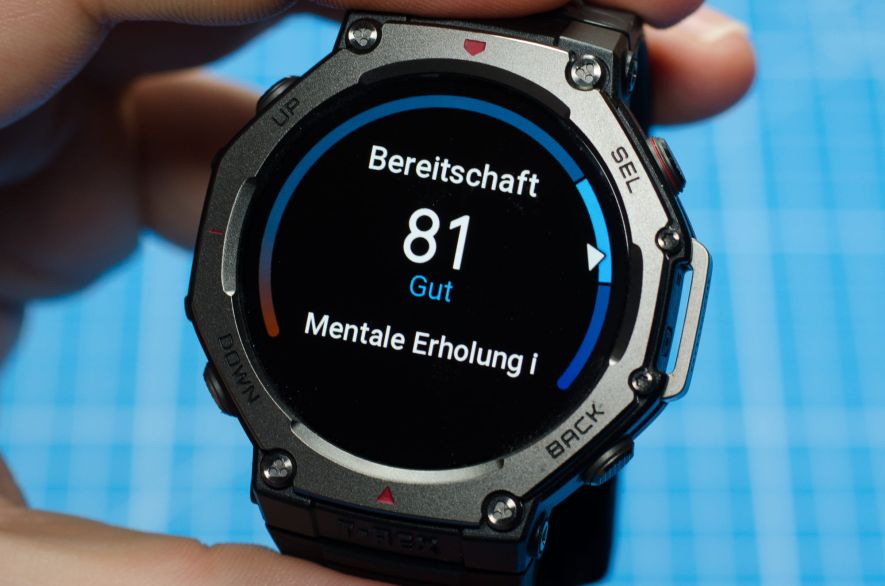
The Readiness Score is generally a useful function to get a quick overview of your current recovery state. I find it helpful that Amazfit provides insights into the different aspects contributing to the overall score.
There are even more detailed insights available in the app. For those interested, additional background information on the individual aspects can be found here.
I am somewhat critical of the often high overall score, even when my sleep or recovery has been suboptimal. Scores above 80 are common, but not every day feels like an “80.” I hope that over time, Amazfit will refine this and make the scores fluctuate more clearly.
Heart Rate Variability
Heart rate variability (HRV) measures the fluctuations in the time span between successive heartbeats and is an important indicator of overall health and stress levels. A high HRV suggests that the body is well able to adapt to different stresses, while a low HRV may indicate stress or exhaustion.
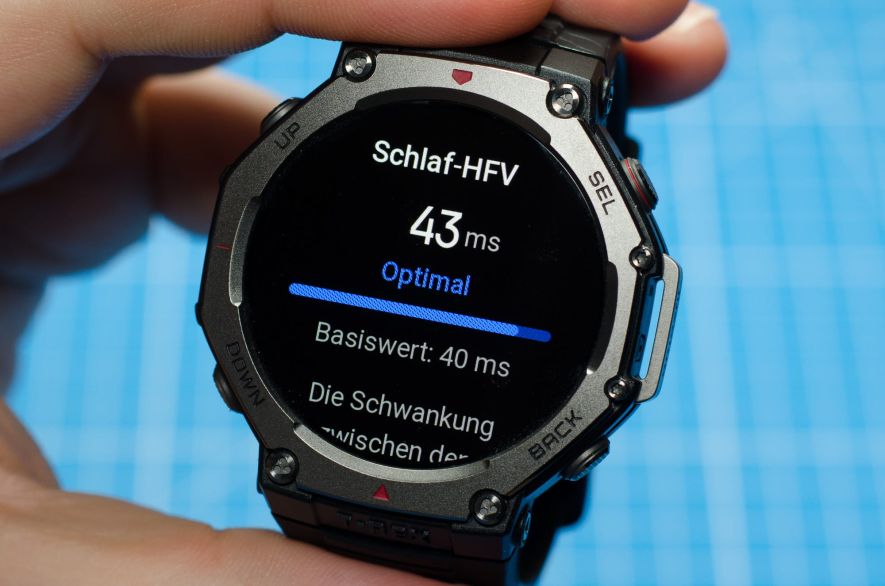
The Amazfit T-Rex 3 continuously monitors HRV at night and provides valuable insights into the autonomic nervous system. HRV analysis helps to better understand how well the body recovers from physical exertion or psychological stress. Especially useful is that HRV data is integrated into various functions like the Readiness Score, providing a more comprehensive view of recovery and readiness for performance. This makes heart rate variability a useful tool for optimizing health in the long run and better managing training and recovery.
PAI – Personal Activity Intelligence
PAI (or: Personal Activity Intelligence) is a fitness metric system based on heart rate and aims to promote long-term health. Rather than focusing solely on steps or calories, PAI calculates the heart rate load during various activities and derives a score from it. The higher and longer the effort, the more points you get. The goal is to consistently achieve a PAI score of 100 or higher to reduce the risk of cardiovascular diseases in the long term.
The first points are easy to earn. The higher the score, the harder it becomes to reach high points, which helps keep motivation high. Points from activities expire after seven days.

I had to get used to PAI after many manufacturers used different metrics as the central tool for an active lifestyle. What I like is that Amazfit doesn’t only consider intense sports sessions but also moderate activities (e.g., brisk walking, hiking) and sometimes even everyday movements. This makes the design of an active day very flexible and more motivating than if a step goal is always looming on the horizon.
However, there is criticism: if a 10-km walk does not raise the heart rate enough, this activity will not contribute to the increase of the PAI score—even if the movement itself should have been beneficial to health.
Features addressing sports
With Amazfit watches, there is always a debate about whether they are sporty smartwatches or smart sport watches. I believe the truth lies somewhere in the middle. In any case, the range of features adressing sports is extensive.
New features of the T-Rex 3 include:
Offline Maps
For those exploring unfamiliar terrain, the T-Rex 3’s offline maps will be a valuable feature. To use them, you must first select the desired map section in the app and transfer it to the watch.
This works flawlessly and, depending on the size of the map section, quite quickly as well. To transfer the map data to the watch, it must be connected to a Wi-Fi network.
Two limitations should be considered:
- Only one map section at a time can be stored on the watch
- Maximum dimensions: 400 x 675 km
The fact that only one map section can be stored on the watch isn’t a major issue for me, but for those traveling frequently across multiple countries and unable to swap out map sections, Garmin and Polar might offer more suitable alternatives.
While the level of detail in cities is quite good, I missed a bit more topographical information in the mountains. The hiking trails were all present, and the contour maps did their job, but a little more geographical detail about the surroundings would have been even better.
Navigation
Offline maps are already a fantastic feature, but they become even more valuable when paired with the route and navigation capabilities of the T-Rex 3.
Routes can be imported either as GPX files or by linking the watch to Komoot. However, integration with Strava for route import is still not supported.
Before starting an activity (e.g., outdoor running, hiking), a route can be selected for use. For the route, you can:
- View a route profile
- View an elevation profile
- Get information on ski slopes
- Set the map orientation (map always points north vs. map points in the direction of movement)
- Set the route direction (from A to B or from B to A)
How the T-Rex 3 gathers information about ski slopes remains a bit of a mystery. Despite the lack of nearby ski areas, the watch still provides slope information. It seems that Amazfit may determine downhill tracks based on longer, downward sections of the route. However, the slope data is limited to an elevation profile rather than a map representation.
During the activity, the map is displayed in the light variant with a white background or in the dark variant with a black background. The colors of the route and the traveled distance can be adjusted in the watch settings (default: Magenta and Blue).
If you deviate from the route, the T-Rex 3 will alert you. However, since the watch doesn’t offer pathfinding, there’s no option to recalculate the way back to the planned route. That said, with the watch warning you after a deviation of just 50 meters, the risk of getting lost is minimal. You can also adjust the maximum deviation setting to trigger earlier or later warnings, depending on your preference.
The watch also acknowledges when you return to the original route.
The distance from the planned route at which the T-Rex 3 warns you can be reduced to 20 meters, or increased if necessary.
When following a route, if a direction change is required, the T-Rex 3 shows the distance to the next turn. Just before the change (e.g., at a junction or fork), the watch reminds you again.
This has worked very well so far, although you have to get used to the fact that sometimes your position is shown slightly off the road: the map material simply does not know the width of roads, so even a road with a green strip in the middle is represented with the same line as a one-lane side street. If there is also a green strip between the road and the sidewalk, your current position may appear a little off the displayed road.
Amazfit can tick off the “Offline Maps and Navigation” feature, although there is still some room for improvement: Currently, only Garmin provides map material that can be used for route finding. For Amazfit, Polar, and others, the maps are no more (but also no less) than images projected onto the current location.
Diving
I unfortunately can’t contribute any personal experience with freediving to this review. However, it should be noted that the T-Rex 3 is certified for dives up to 45 meters deep.
It apparently measures the current and maximum dive depth, dive time, and ascent speed. However, essential metrics for a real dive computer are missing, such as No-Decompression Limits (NDL), decompression stops, and surface intervals.
Before Recording
Before starting a sports activity, you select the appropriate sport from the sports menu.
Then, for outdoor activities, the T-Rex 3 searches for a GNSS signal. Like most Amazfit models, it is one of the faster ones. A satellite fix is found within seconds.
At this point, you can not only wait for signals from satellites and external sensors (e.g., Bluetooth heart rate straps) but also adjust settings for the upcoming recording, such as selecting routes, intervals, and workouts. You also have the option to configure the data pages and fields for display during recording: The T-Rex 3 allows up to 6 data fields per data page.
After Recording
After completing the recording, the watch briefly summarizes the sporting aspects.
You can browse through a variety of details and charts that essentially display the values that can also be found in the app after synchronization.
The T-Rex 3 benefits once again from its high-resolution 1.5″ display.
In the app, the data is, of course, even more clearly displayed:
The app has a clean and organized interface, and many of the metrics it provides are comparable to those found in Garmin devices. However, especially for power measurement and training effects, the results may differ, as each company uses its own algorithms for these calculations.
Accuracy of location tracking
For many, the quality of a sports watch largely depends on the accuracy of its GPS, or more broadly, its GNSS capabilities. The T-Rex 3 supports not only dual-band GPS but also GLONASS, Galileo, BeiDou, and QZSS. This is an important feature, as accurate location tracking becomes crucial when venturing off familiar paths.
While there are no mountains, canyons, or other challenging conditions in the suburban areas around Berlin, I tested the watch on familiar routes, both with and without tree cover, through areas with terraced houses and narrow streets to see how well it performed.
What stood out was how effortlessly the T-Rex 3 handled these conditions. There was no reason to complain about its performance, and even the short section through the forest was navigated without issue.
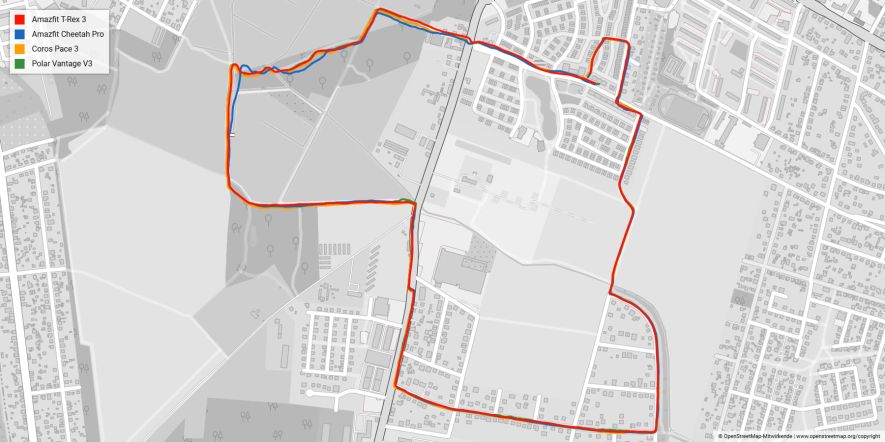
From a high vantage point, it becomes clear that the GNSS chip and antenna design of the T-Rex 3 do their job seamlessly.
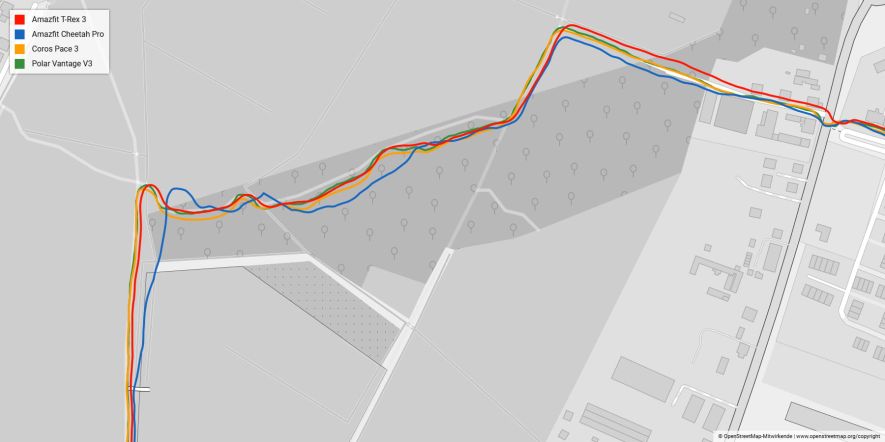
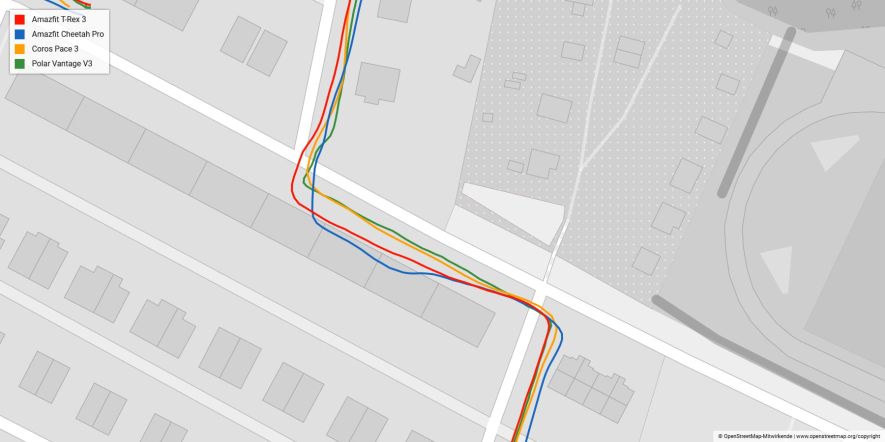
Only when looking closely do you see some deviations that both Amazfit models share. However, there is nothing significant, and regardless of which products you use, you will occasionally notice slight offsets from the actual path.
| Product | Distance | Pace |
|---|---|---|
| Amazfit T-Rex 3 | 5.06 km | 7'20" |
| Amazfit Cheetah Pro | 5.03 km | 7'23" |
| Coros Pace 3 | 5.10 km | 7'18" |
| Polar Vantage V3 | 5.09 km | 7'19" |
In the end, I consider the deviations to be negligible.
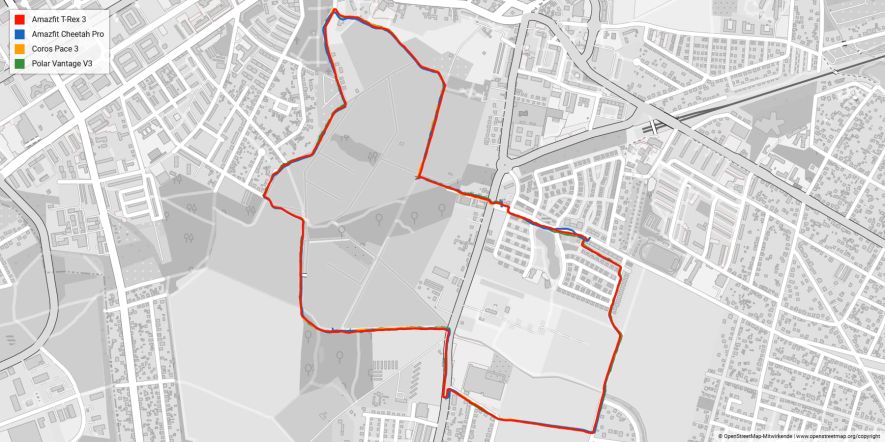

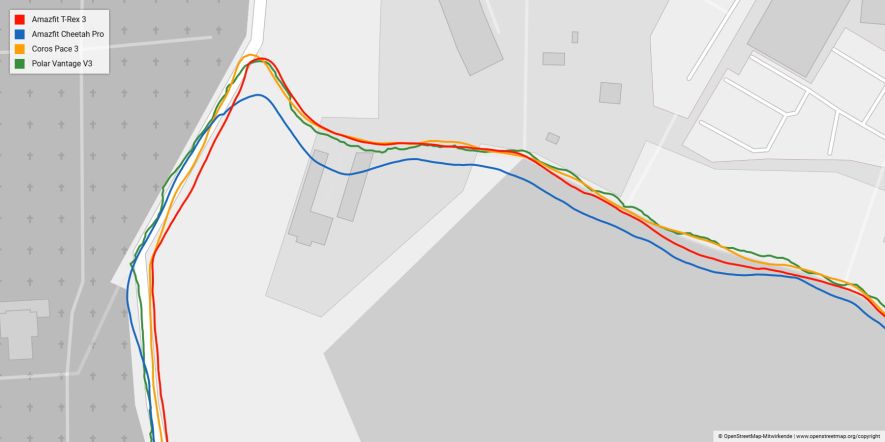
In the next test, there was again a high level of agreement with the competition, though some deviations appeared upon closer inspection. This is not uncommon right after the start of the recording, when, although sufficient satellite signals are available for an initial location fix, a greater number of GNSS signals would improve the reliability of the positioning.
Accuracy of Heart Rate Monitoring
As always, I not only looked at the accuracy of the GPS tracking but also checked how accurately the T-Rex 3 measures the heart rate.
As a reference, I used the Polar H10 chest strap, with which I have always had excellent experiences, and by which most products are evaluated.
I’m not sure if it is obvious from the curves, but the effects of my COVID infection from early September still make my body feel strained during exercise. What’s important is how the T-Rex 3 compares to the Polar H10 and how it holds up against the competition.


During a run with some intervals, surprisingly, it is the heart rate chest strap that seems to have issues. If I had to guess the reason today, I would suspect too dry skin or contact issues with the chest strap. However, I can’t say for sure. Since the Polar H10 remains a stable measuring instrument, I excluded the initial anomalies for further analysis.

The difference chart highlights the solid performance of the T-Rex 3, although it falls behind during intervals and doesn’t always capture rapid heart rate spikes accurately.
This is reflected in the coefficient of determination (r²), which indicates how well the values from one or the other sport watch matches the heart rate chest strap, which serves as the reference here.
The T-Rex 3 can’t quite top the comparison and has to let the Coros Pace 3 take the lead. However, it still performs better than the Amazfit Cheetah Pro, which was even less accurate in tracking heart rate during the intervals.
With fewer pace changes, the T-Rex 3 consistently provided reliable and comparable values. During rapid changes in heart rate, it faces the same challenges as many competitors and therefore doesn’t stand out either positively or negatively.
Battery Life
On paper, the T-Rex 3 stands out as a true battery life champion. However, confirming or disproving this through user testing is still challenging for me, even after nearly 10 years of testing sports watches.
Company-provided specifications are typically based on controlled environments, so they serve as a general indication rather than an absolute benchmark for real-world usage. Even small changes, such as additional screen activations or adjusting the brightness, can cause these numbers to vary.
As mentioned, the T-Rex 3 impresses on paper, and the great news is that it performs just as well in everyday use. I managed to get through the first three weeks without a charge, although my sports activity was minimal. It was only when the battery dropped to 8% that I needed to recharge.
In the following weeks, the T-Rex 3 had to record activities more frequently. This not only draws more power due to the active GNSS, but the PPG sensor also works at a second-by-second rate.
What does this mean in the end? The battery life specs seem plausible, although I cannot fully validated them due to varying usage. Is this important? No, because the T-Rex 3 offers an impressive battery life regardless and is quickly recharged for the next use.
Amazfit T-Rex 3 - Verdict

- Great 1.5" AMOLED display
- Offline maps / navigation
- Extensive metrics
- Battery life
- Value-for-money ratio
- limited support to Zepp Pay
- Music upload / playlists
- Apps
The Amazfit T-Rex 3 is a successful blend of a rugged outdoor smartwatch and a smart health companion. Its impressive value-for-money ratio stands out: it offers a wide range of fitness metrics, including Readiness Score, PAI, and HRV analysis, supporting an active and health-focused lifestyle. Outdoor enthusiasts will especially appreciate the offline maps and GNSS support, which provide reliable navigation in various terrains.
Another standout feature is the battery life; even with intensive use, it lasts exceptionally long, making it an attractive option for frequent users and adventurers. The solid build quality, excellent 1.5″ AMOLED display, and intuitive app complete the overall package.
While the T-Rex 3 may not match the Fenix 8 in app variety, advanced mapping features, music functionality, or premium material quality, it certainly holds its own as a competitor. For those unwilling to pay three to four times the price, the T-Rex 3 stands out as an excellent alternative.
Disclosure: The Amazfit T-Rex 3 to me by Zepp, free of charge, at my request for testing. No conditions were attached to this review, and the opinions and experiences shared here reflect my entirely unbiased assessment of the product.

